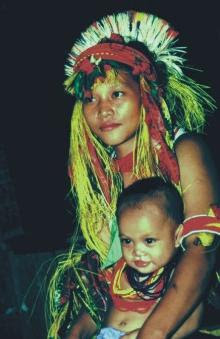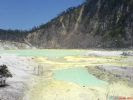The Jakarta
Sunda Kalapa was the main port of the Hindu Kingdom of Sunda. The capital of the Pakuan Pajajaran kingdom was located two days journey upriver, now known as Bogor. Ships often visited this port from Palembang, Tanjungpura, Malacca, Maccasar and Madura, and even by merchants from India and South China. Sunda Kelapa exported, among other items, pepper, rice and gold.
In 1513 the first European fleet, four Portuguese ships under the command of Alvin, arrived in Sunda Kelapa from Malacca. Malacca had been conquered two years earlier by Alfonso d' Albuquerque. They were looking for spices, especially pepper, to this busy and well-organized harbor. Some years later, the Portuguese Enrique Leme visited Kalapa with presents for the King of Sunda. He was well received and on August 21, 1522 signed a treaty of friendship between the kingdom of Sunda and Portugal. The Portuguese received the right to build a go down (warehouse) and to erect a fort in Kalapa. This was regarded by the Sundanese as a consolidation of their position against the encroaching Muslim troops from the rising power of the Sultanate of Demak in Central Java.
To commemorate this treaty, they put big stone, called a Padrao, which vanished for some years. This stone was uncovered later in 1918 during an excavation for a new house in Kota area on the corner of Cengkeh Street and Nelayan Timur Street. This Padrao can now be seen in the National Museum on Medan Merdeka Barat Street. The original location of the stone suggests that the coastline in the early 16th century formed a nearly straight line, which is marked by the present of Nelayan Street, some 400 meters south to the Lookout Tower. The King of Sunda had his own reasons for great danger from the expansive Muslim Kingdom of Demak, whose troops threatened his second harbor town, Banten (west of Jakarta). Sunda felt squeezed and was in need of strong friends. Thus, the king hoped the Portuguese would return quickly and help him protect his important harbor. But they came too late. For in 1527 the Muslim leader Fatahillah appeared before Kalapa with 1,452 soldiers from Cirebon and Demak.
According to some historians, this victory of 1527 provided the reason for Fatahillah to rename Sunda Kelapa, Jayakarta, which means "Great Deed" or "Complete Victory." On the basis of this victory, Jakarta celebrates its birthday on June 22, 1527; the day Fatahillah gave the town a name of victory of over Sundanese Hindus and Portuguese sailor. Prince Jayawikarta, a follower of the Sultan of Banten, resided on the west banks of Ciliwung river, which in the early 17th century reached the roughly at our starting place, the Lookout at Pasar Ikan. He erected a military post there in order to control the mouth of the river and the Dutch who had been granted permission in 1610 to build a wooden go down and some houses just opposite there on the east bank. Dutch ships had already come to Jayakarta in 1596. The Prince tried to keep a close eye on these unruly guests.
To keep its strength equal to that of the Dutch, Prince Jayawikarta allowed the British to erect houses on the West Bank of Ciliwung River, across the Dutch go down, in 1615. The Prince granted permission to the British to erect a fort closed to his Customs Office post. Jayawikarta was in support of the British because his palace was under the threat of the Dutch cannons. In December 1618, the tense relationship between Prince Jayawikarta and the Dutch escalated. Jayawikarta soldiers besieged the Dutch fortress that covered two strong go down, namely Nassau and Mauritus. The British fleet made up of 15 ships arrived. The fleet was under the leadership of Sir Thomas Dale, former governor of the Colony of Virginia, now known as Virginia State in the United States.
The British admiral was already old and was indecisive. After the sea battle, the newly appointed Dutch governor Jan Pieter Soon Coon (1618) escaped to Molucca to seek support. Meanwhile, the commander of the Dutch army was arrested when the negotiation was underway because Jayawikarta felt that the Dutch deceived him. Then, the Prince Jayawikarta and the British entered into a friendship agreement.
The Dutch army was about to surrender to the British when in 1619, a sultan from Banten sent soldiers and summoned Prince Jayawikarta for establishing closed relationship with the British without first asking an approval from Banten authorities. The conflict between Banten and Prince Jayawikarta as well as the tensed relationship between Banten and the British had weakened the Dutch enemy. Prince Jayawikarta was moved to Tanara and died in Banten. The Dutch felt relieved and tried to establish a closer relationship with the Banten. The Dutch fortress garrison, along with hired soldiers from Japan, Germany, Scotia, Denmark, and Belgium held a party in commemoration of the change in situation. They name their fortress after Batavia to recollect the ethnic group Batavier, the Dutch ancestor. Since then Jayakarta was called Batavia for more than 300 years.
Under the relationship of J.P Coen, Dutch army attacked and destroyed the city and Jayakarta Palace on May 30, 1619. There were no remains of Jakarta except for the Padrao stone now stored at the National Museum in Jakarta. The Jayakarta grave was possibly located in Pulau Gadung. If we stand on top of Menara Syahbandar and look around, we can enjoy the beautiful panorama in the oldest area of Batavia. Certainly, we can't enjoy the remains of the city Sunda Kelapa or Jayakarta. Kasteel or the Dutch fortress, too, has been destroyed. Here we can see several remains from the mid-17th century. Nearly all of the remains are related to trade and sailing.
Syahbandar Tower was built 1839 to replace the old flagpole in ship dock located right on the side across a river. From the pole and later the tower, officials observed ships about to anchor gave signals. The tower then is used a meteorology post. To the West of the Lookout Tower, we can see the view of the present Bahari Museum. The museum represents a very old and strong edifice with Dutch architecture. The museum also provides several maps of the city, with stages of the city development shown. The museum is part of something in Dutch called Westzijdsche Pakhuizen (Warehouse on the West bank. Here nutmegs, pepper, coffee, tea, and cloth in a large scale were used to be stored.
The area around Syahbandar Tower was once the center of Kota Batavia. It was the center of a trading network with wide spread agents reaching Deshima (Nagasaki) in Japan, Surate in Persia and Cape town in South Africa. Inter-trade among Asia was more profitable than inter-trade between Asia and Europe. And the Pasar Ikan (Market Fish) once was the pulse. Here, the site where the origin of the capital of Indonesia, Jakarta, came from.
Jakarta History Museum
 Located in the historic Old Jakarta Kota area, Taman Fatahillah square offers three of the city's most interesting museums. Once the heart of the colonial administration in the 18th century the square underwent a major restoration in the 1970's. A fountain in the middle of square once as the main water supply for the former colonial capital. The Portuguese cannon on the north side of the square is reportedly an impressive font of fertility. Jakarta History Museum is the one displaying the history of the development of the City of Jakarta, both the events and the community, from the prehistory until these present days. This museum is located in a building of cultural property which in the past known as Stadhuis, the City Hall of Batavia. As written on an inscription of the Museum collection, the building was constructed in 1707 by the city government of Batavia during the period of VOC and Governor General Abraham van Riebeeck inaugurated it in 1710. This building is located in front of a park, which in the past was known as Stadhuisplein, the City Hall Park, and now it is called Taman Fatahillah.
Located in the historic Old Jakarta Kota area, Taman Fatahillah square offers three of the city's most interesting museums. Once the heart of the colonial administration in the 18th century the square underwent a major restoration in the 1970's. A fountain in the middle of square once as the main water supply for the former colonial capital. The Portuguese cannon on the north side of the square is reportedly an impressive font of fertility. Jakarta History Museum is the one displaying the history of the development of the City of Jakarta, both the events and the community, from the prehistory until these present days. This museum is located in a building of cultural property which in the past known as Stadhuis, the City Hall of Batavia. As written on an inscription of the Museum collection, the building was constructed in 1707 by the city government of Batavia during the period of VOC and Governor General Abraham van Riebeeck inaugurated it in 1710. This building is located in front of a park, which in the past was known as Stadhuisplein, the City Hall Park, and now it is called Taman Fatahillah.
National Monument
 The National Monument, or "Monas" as it is popularly called, is one of the monuments built during the Sukarno era of fierce nationalism. The top of the National Monument (Monas) is Freedom Square. It stands for the people's determination to achieve freedom and the crowning of their efforts in the Proclamation of Independence in August 1945. The 137-meter tall marble obelisk is topped with a flame coated with 35 kg of gold. The base houses a historical museum and a hall for meditations. The monument is open to the public and upon request the lift can carry visitors to the top, which offers a bird's eye view on the city and the sea.
The National Monument, or "Monas" as it is popularly called, is one of the monuments built during the Sukarno era of fierce nationalism. The top of the National Monument (Monas) is Freedom Square. It stands for the people's determination to achieve freedom and the crowning of their efforts in the Proclamation of Independence in August 1945. The 137-meter tall marble obelisk is topped with a flame coated with 35 kg of gold. The base houses a historical museum and a hall for meditations. The monument is open to the public and upon request the lift can carry visitors to the top, which offers a bird's eye view on the city and the sea.


Comments
Post a Comment